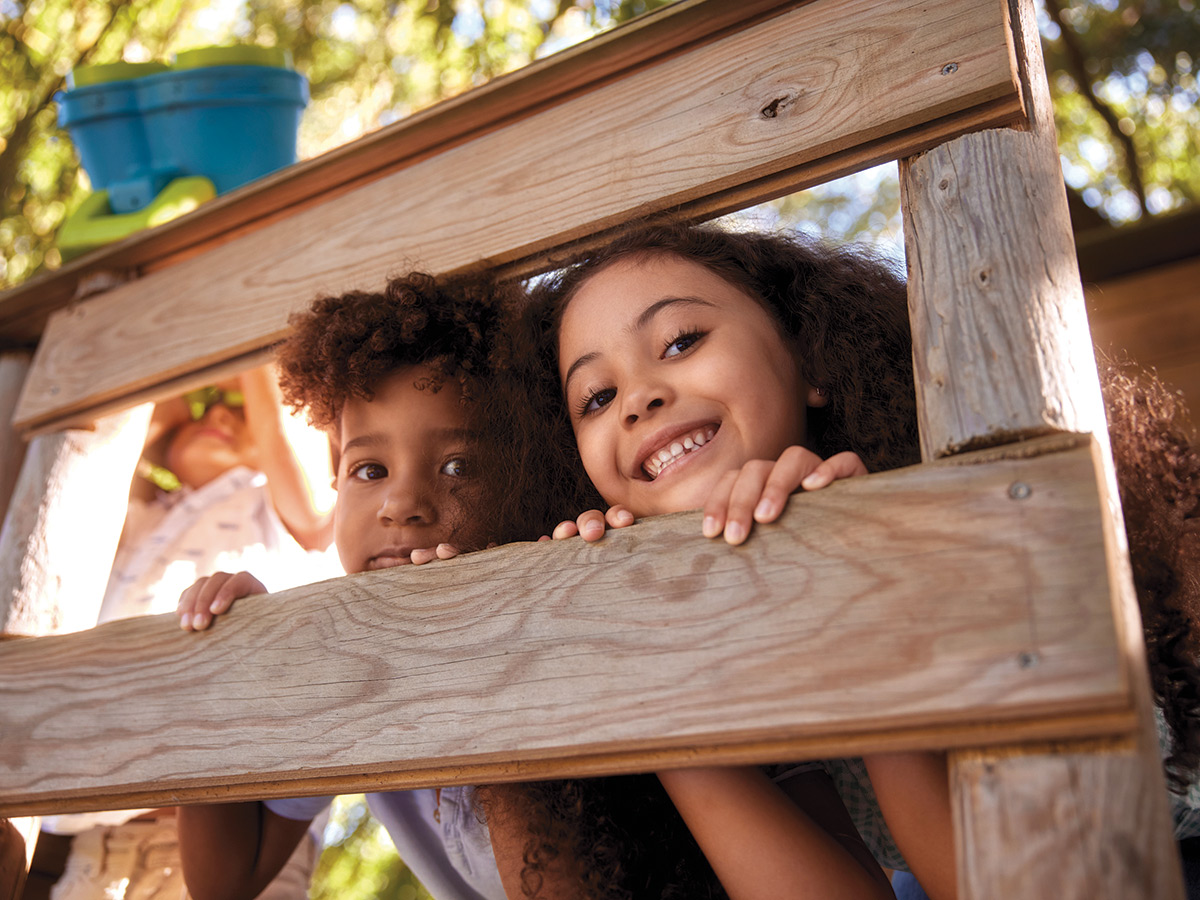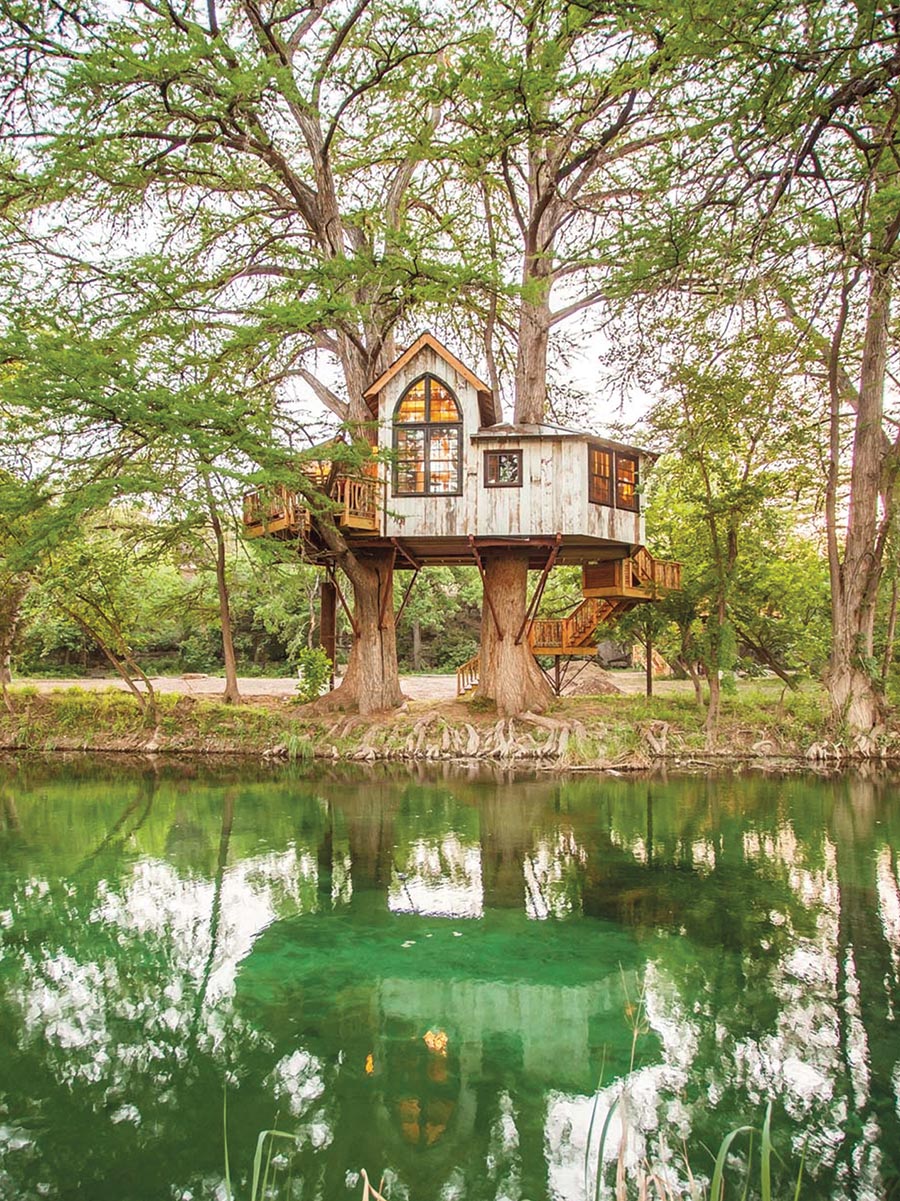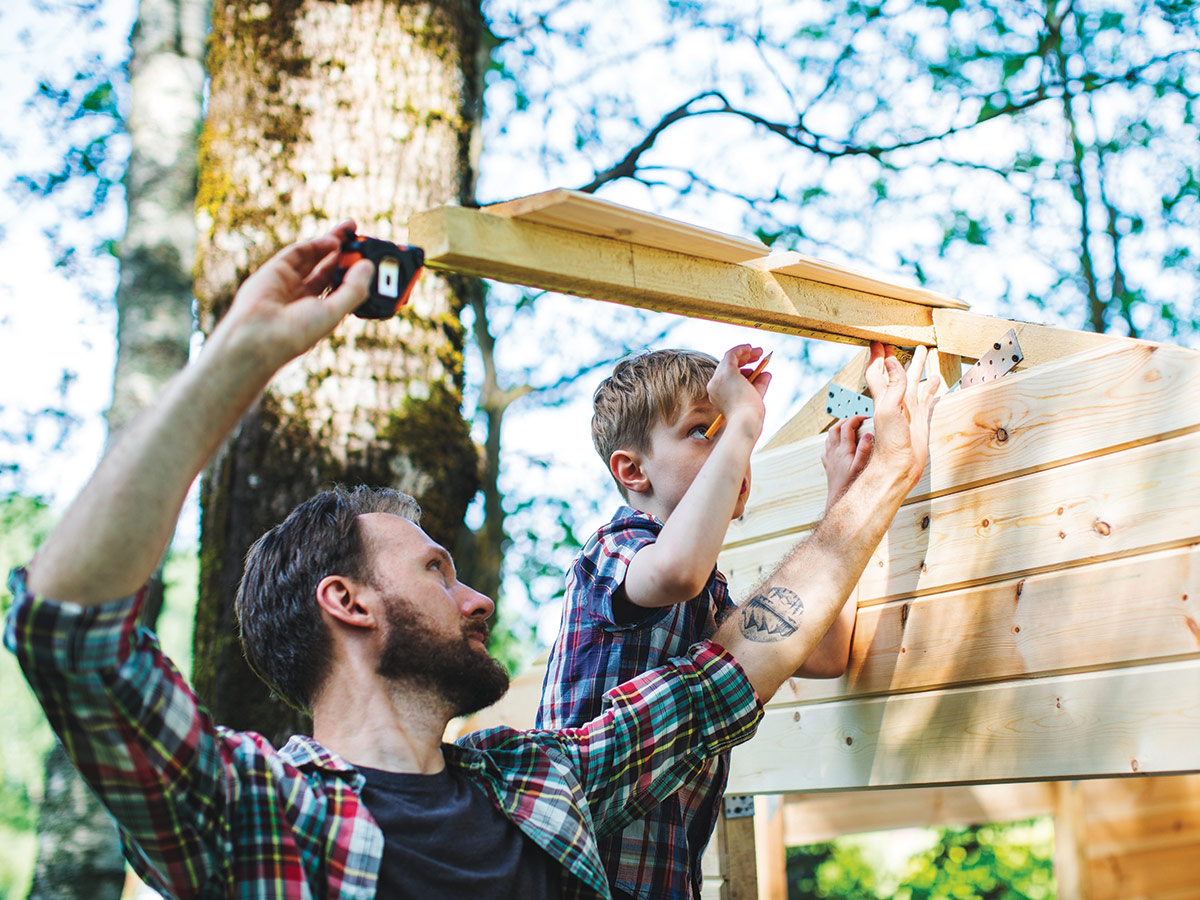In the Canopies

Treehouses provide space for creativity and opportunities to cooperate with friends and siblings. PHOTO wundervisuals/iStock
Youngsters growing up along rivers discover all kinds of washed-up scrap wood and debris. You never know what might appear on a bank or become stuck in vegetation. Phillip Schulze, the Wildflower Center’s arboretum and natural areas manager, used what he found as a boy to build a treehouse in a box elder (Acer negundo), creating a platform and even including a fireplace. “The best part was that you could fish from right up in the treehouse,” he says.
Most kids’ treehouses aren’t quite as elaborate, and Schulze readily admits the one he built for his son, in a 50-foot-tall pecan (Carya illinoinensis) in his current backyard, is simple but solid. That’s fine, according to Michelle Bertelsen, an ecologist for the Wildflower Center and mother of three, who sees treehouses as important facilitators of nature play.
It’s nice to have a larger structure, like a treehouse, that acts as a jumping off point for imaginative play,” says Bertelsen, “the type that encourages children to have more unstructured time outside with materials that are not defined.” She describes herself and cousins as “free-range kids” while playing at their grandfather’s. “We found old wood, climbed up a tree, and hammered it in all kinds of places. It never looked like more than attached pieces of wood, but we spent a lot of time planning it and playing there.”
Bertelsen says children not only exercise large motor skills building and playing in a treehouse, but they also learn math and physics through measuring and understanding balance. Communication skills, cooperation, and creating rules and structure (e.g., “Who will be president of this secret treehouse club?”) are all tested and honed.
But treehouses aren’t just for kids. Adults similarly enjoy backyard getaways, art studios, writing nooks and home offices among leafy limbs. With the privacy, safety and convenience of backyards taking on more importance during COVID-19 times, treehouses became even more appealing, their status elevated. Who can resist the peace and beauty of being among branches, leaves applauding you in a gentle wind, and a unique perspective on the world?

Pete Nelson’s treehouses fall into the fantasy category, proving high-end versions have appeal (and a market) too; the Chappelle is one of four rentable Hill Country getaways. PHOTO Treehouse Utopia
Pete Nelson, internationally known custom treehouse designer/builder and star of “Treehouse Masters,” a TV series on Animal Planet, says adults use treehouses today as creative spaces to write or paint — or simply as places “to disconnect from the lives we all have to live.”
Luxury treehouses such as Nelson’s can be found in private backyards or in hospitality situations, including rental getaways such as his current project, Treehouse Utopia, near the Hill Country town of the same name. At $475 per night, his Chapelle treehouse is on the extravagant side. But we’ve gathered advice from a variety of pros to help you bring nature play and creative space to your own canopies.
IDENTIFY BEST-SUITED TREES
“You have to make do with what you have,” says artist James Edward Talbot, creator of imaginative structures such as the treehouselike-but-earthbound Fairy Pavilion, which won the People’s Choice Award at the Wildflower Center’s 2019-20 Fortlandia exhibition. “Not everyone has the perfect tree in their backyard for a treehouse. But that shouldn’t stop anyone,” he says.
“Ashe junipers are a nuisance to many people in the Hill Country, but they are hardy and rot resistant. People try to get rid of the logs, so I have a gold mine of that wood to work with,” says Talbot. In fact, his Fairy Pavilion made great use of them. He stays away from live oaks (Quercus virginiana or Q. fusiformis) even though they are “very picturesque,” because they are susceptible to oak wilt.
Schulze, however, says live oaks’ sheer numbers make them a popular treehouse species. He also gives a thumbs up to bur oak (Q. macrocarpa), chinquapin oak (Q. muehlenbergii) and Monterrey oak (Q. polymorpha): “All of those are very strong trees and have a branching structure that lends itself to making a treehouse, as opposed to something like a pine that is more vertical,” says Schulze. “Avoid weak wood trees like hackberry (Celtis spp.) and invasive Chinaberry (Melia azedarach).”
Nelson also votes for oaks, including post oaks (Q. stellata), because of their sturdiness. But he says it’s important to “get into a majestic tree like an oak” without cutting off a large limb if possible. He also recommends Douglas fir (Pseudotsuga menziesii) and Texas’ bald cypress (Taxodium distichum), which can be “beautiful and enormous with roots that go right down to rivers,” as other great native species for treehouses.
But he agrees with Talbot about working with what you have: “I used to tell people that a willow would never do for a treehouse,” says Nelson, who lives in Seattle, where willows often occur in “idyllic settings” along waterways but aren’t the strongest option. “Most kids’ treehouses are going to last five or six years,” he says, “unlike the kind we build meant to last much longer. Kids will say the willow is great, and they are right if that’s what they have.”
DO NO HARM
Schulze admits he would never again build a treehouse the way he did as a child, for fear of harming a tree. “The less weight you put in a tree, the better,” he says. “And anytime you put hardware into a tree you are creating potential for some kind of wound. Even a nail or screw can lead to fungal decay.” Luckily, there are ways to build freestanding structures that don’t rely on trees for support. Schulze built his son’s treehouse by placing posts in the ground to support a platform, not even touching the tree.
He also recommends hand digging post holes to avoid harming tree roots, digging holes at least 6 feet from the trunk to avoid buttress roots (a tree’s large roots on all sides), and adjusting the space a few inches between posts if a large root is uncovered.
Nelson uses special hardware and three different attachment systems to minimize tree damage. Which system he employs depends on a project’s needs, from backyard fort to commercial lodging, but all use steel attachment bolts. Trees grow around the bolts, resulting in an even stronger connection. He says he’s amazed at many species’ healing ability.
To discourage tree disease or injury, Talbot suggests always using clean work tools (including saws), not wrapping tree trunks or branches, and leaving sufficient space around platforms for future trunk growth.

Building a treehouse together can be a memorable experience for families — and parents get to enjoy the end result too. PHOTO yulkapopkova/iStock
REMEMBER THE MAGIC
Nelson’s father built a small treehouse in the backyard where he grew up near New York City more than 50 years ago. Recently, Nelson went back to see his childhood home. The treehouse and maple tree were gone, but his memories of the treehouse were still vivid. That fondness was probably a factor in his choosing treehouse building instead of traditional residential construction and architecture. “No concrete, foundations, rebar,” says Nelson. “The trees do it all for you. They are special, and I like to think they are happy to be chosen.”
Talbot believes the mere fact that something is a treehouse doesn’t make it a magical place, however. “You have to figure out the basic reasons why someone wants a treehouse, and then let them figure out how the treehouse can become theirs,” he says.
He’s onto something. Whether a treehouse is a calm oasis beyond regular life, a creative studio, or a place to explore and pretend, it is as individual as each of us — and unique in the ways it connects us with nature.
Jill Sell is a freelance journalist, essayist and poet, specializing in the environment and nature. She is a contributing writer for Gannett/USA Today and was named Best Freelance Writer in Ohio by The Press Club of Cleveland five times.
